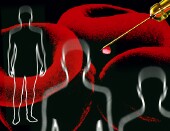Scientists Discover Protein Involved in Fat Production
Mouse experiments might lead to new target for treating high cholesterol, researchers say.
By Steven Reinberg
HealthDay Reporter
|
E-mail this article
Subscribe to news
Printer friendly version
|

(SOURCES: Ann-Hwee Lee, Ph.D., Harvard School of Public Health, Boston; Jay D. Horton, M.D., Dr. Robert C. and Veronica Atkins Chair in Obesity and Diabetes Research, and professor, internal medicine, digestive and liver diseases, University of Texas Southwestern Medical Center at Dallas; June 12, 2008, Science, online)
THURSDAY, June 12 (HealthDay News) -- In experiments with mice, researchers have found a protein in the liver involved in regulating the production of fat molecules.
The finding could provide a new target for treating high cholesterol or fatty liver disease.
"We identified a novel transcription factor that regulates lipid synthesis in the liver," said lead researcher Ann-Hwee Lee, from the Harvard School of Public Health. "This transcription factor is activated in response carbohydrate intake."
This protein, called XBP1, is another key transcription factor regulating lipid production in the liver in response to high carbohydrate intake, Lee said. "So, mice that do not have XBP1 have dramatically reduced plasma lipids, such as cholesterol and fatty acids," he explained.
Lee's team found this protein switches genes involved in fat metabolism on and off.
The report is published in the June 12 online edition of Science.
In the current study, Lee's group used mice that had no XBP1 expression in the liver. These mice showed lower levels of cholesterol and fatty acids in the blood because of reduced production of fats.
This discovery could lead to new ways for treating high cholesterol, Lee said.
"We hope by controlling this pathway, we may be able to control the human diseases caused by increased levels of lipids," Lee said.
Any drug that would target XBP1 would work differently than statins, Lee noted. "The advantage of a drug that targets XBP1 is that it controls both cholesterol and fatty acids," he said.
However, there is also a big disadvantage to such a drug, Lee said.
"Unfortunately, XBP1 is expressed everywhere in the body, and it has a dual function," Lee said. "It controls lipids, but it also has a role in protein secretion. So, any drug that eliminates XBP1 not only reduces lipids, but it also interferes with the normal functioning of cells. So, we would have to find a drug-delivery system that specifically targets XBP1 in the liver."
One expert thinks this finding could lead to new ways to reduce fats linked to cardiovascular and other diseases.
"The main findings of this paper was the unexpected consequences of this protein," said Dr. Jay D. Horton, the Dr. Robert C. and Veronica Atkins Chair in Obesity and Diabetes Research and a professor of internal medicine, digestive and liver diseases at the University of Texas Southwestern Medical Center at Dallas. He also authored an accompanying journal editorial.
"This protein provides a potential new target for reducing cholesterol and fat synthesis in the liver, which could have a positive impact on certain disease processes, such as high cholesterol and high triglyceride levels in the blood," Horton said.
Such a drug could also help treat fatty liver disease, which is a condition where there is too much fat in the liver, Horton said.
"However, how this would work in humans isn't known, and neither is the safety of such a drug," Horton said.
More information
For more on cholesterol, visit the U.S. National Library of Medicine.
Copyright © 2008 ScoutNews, LLC. All rights reserved. 
HealthDayNews articles are derived from various sources and do not reflect federal policy. healthfinder.gov does not endorse opinions, products, or services that may appear in news stories. For more information on health topics in the news, visit the healthfinder.gov health library.